Are you ready to transform your outdoor space into a stunning garden? Discover the secrets to designing a beautiful and effortless garden with these basic garden design ideas.
Unlocking your green thumb and designing a beautiful garden doesn’t have to be difficult. Here are some basic garden design ideas to help you create your outdoor oasis. If you have poor soil or limited space, consider using raised beds or containers. Adding a greenhouse can extend your growing season and protect plants. Thinking big and using mature plants can create a bold and confident garden.
Don’t be afraid to mix different plant materials in containers for a natural and breezy feel. Growing vines can add a touch of romance and are easy to care for. Consider using low-maintenance plants and incorporating statement trees for impact. Perennials and well-manicured shrubs can add beauty and movement to your garden. Don’t forget to choose the right soil, keep critters away, and water your plants correctly. With these tips and a little experimentation, you can create a beautiful and thriving garden.
Key Takeaways:
- Use raised beds or containers if you have poor soil or limited space.
- Consider adding a greenhouse to extend your growing season and protect plants.
- Think big and use mature plants for a bold and confident garden.
- Mix different plant materials in containers for a natural and breezy feel.
- Growing vines can add a touch of romance and are easy to care for.
Creating Basic Garden Designs for Beginners
If you’re new to gardening and looking for basic design ideas, this section will guide you through creating simple yet stunning garden layouts that are perfect for beginners. Unlocking your green thumb and designing a beautiful garden doesn’t have to be difficult. With a little guidance and experimentation, you can create an outdoor oasis that reflects your personal style.
To start, consider using raised beds or containers if you have poor soil or limited space. These options allow you to control the quality of your soil and maximize the use of your available space. Raised beds are also easier to maintain and can prevent weeds from taking over your garden.
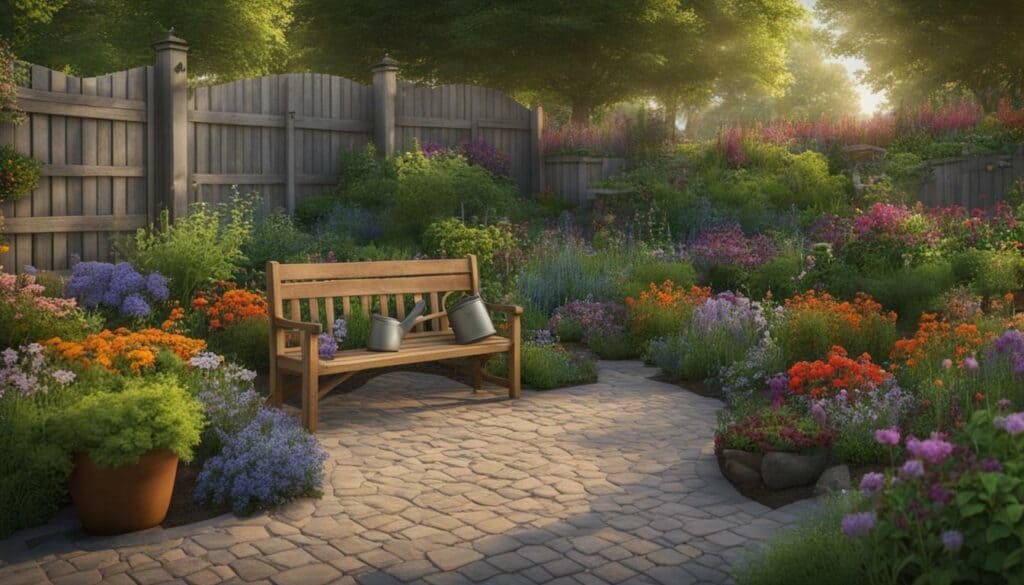
Another great addition to your garden is a greenhouse. Not only does it extend your growing season, but it also provides a protective environment for your plants. You can start seedlings earlier in the year and keep delicate plants safe from harsh weather conditions.
When it comes to the design of your garden, don’t be afraid to think big. Using mature plants can create a bold and confident garden. These plants have already established their root systems and will provide instant impact. Combine different plant materials in containers to create a natural and breezy feel. Mixing flowers, herbs, and foliage plants in one container adds visual interest and creates a sense of harmony.
Remember to choose low-maintenance plants that are suitable for your climate and garden conditions. Incorporating statement trees can also add a wow factor to your garden. These larger trees create focal points and make a strong visual impact. Finally, perennials and well-manicured shrubs are excellent choices for adding beauty and movement to your garden. They come back year after year and require minimal maintenance.
Don’t forget the basics of gardening: choose the right soil, keep critters away, and water your plants correctly. By following these simple design ideas and tips, you can create a beautiful and thriving garden that will bring you joy for years to come.
Maximizing Small Spaces with Easy Garden Plans
Have a small outdoor space? Don’t worry! Learn how to maximize your garden’s potential with these easy garden plans and small space garden ideas. Even with limited room, you can still create a beautiful and thriving garden that will bring joy and tranquility to your outdoor oasis.
One effective way to make the most of small spaces is by utilizing raised beds or containers. These allow you to grow a variety of plants in a compact area and also provide better control over the soil quality. Consider using vertical gardening techniques such as trellises or hanging baskets to maximize vertical space. By thinking creatively, you can turn even the tiniest nooks and crannies into a lush green sanctuary.
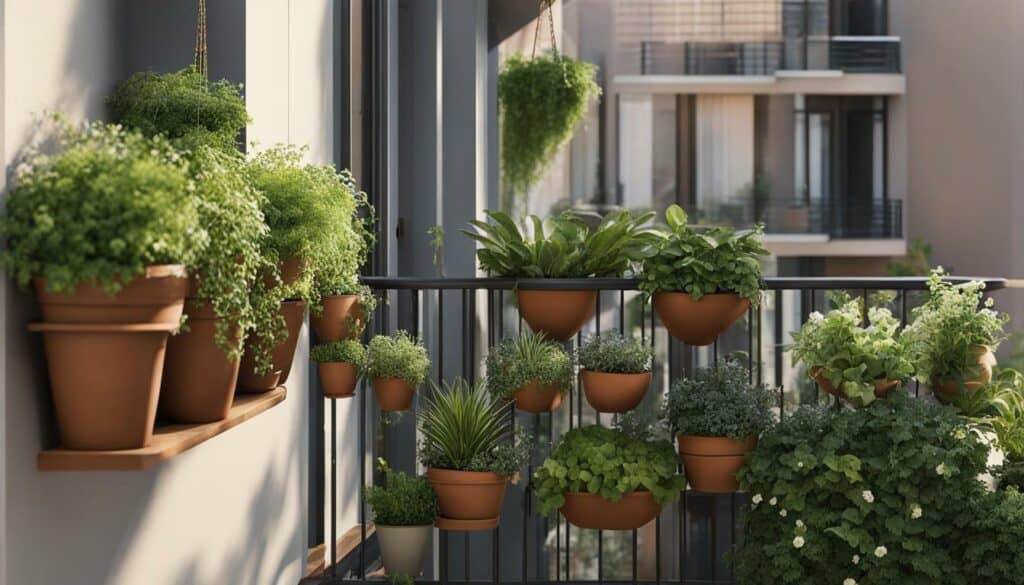
To extend your growing season and protect delicate plants from harsh weather conditions, consider adding a greenhouse to your small garden. This structure will provide a controlled environment where you can nurture your plants and ensure their optimal growth. With a greenhouse, you can start your seedlings early in the season and enjoy fresh produce throughout the year.
With these easy garden plans and small space garden ideas, you can transform your compact outdoor area into a thriving green space. Whether you opt for raised beds, containers, vertical gardening, or a greenhouse, the key is to think creatively and make the most of the space you have. With a little planning and experimentation, you can create a beautiful garden that brings joy and relaxation to your life.
Budget-Friendly Garden Designs that Wow
Designing a beautiful garden doesn’t have to drain your wallet. Explore these budget-friendly garden designs and DIY ideas to create a stunning outdoor oasis without breaking the bank. If you’re working with poor soil or limited space, consider utilizing raised beds or containers. Not only do they solve common gardening challenges, but they also provide a visually appealing element to your garden.
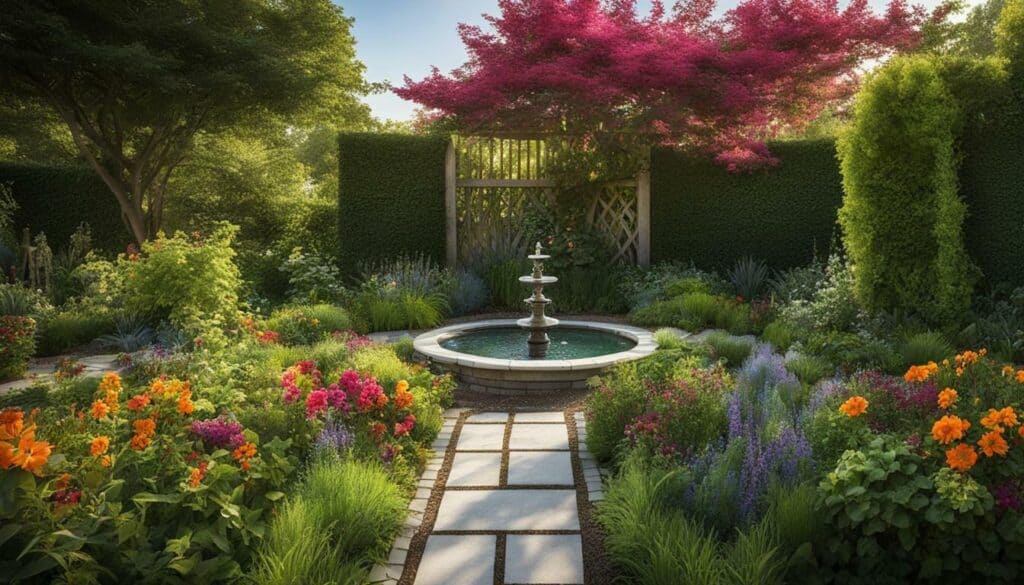
Another cost-effective option is to add a greenhouse to your garden. Greenhouses not only extend the growing season but also serve as protection for your plants. Building a simple DIY greenhouse using recycled materials can save you a significant amount of money while still providing a suitable environment for your plants to thrive.
Thinking big and using mature plants can create a bold and confident garden design. Mature plants are often more affordable than smaller ones and can instantly transform your garden’s appearance. Combine them with colorful flowers and well-placed accessories for maximum impact.
DIY Garden Designs Ideas |
Budget |
Materials |
|---|---|---|
| Vertical pallet garden | Low | Wooden pallets, planters, soil |
| Upcycled tire planters | Low | Old tires, paint, soil |
| Recycled bottle borders | Low | Plastic bottles, scissors, soil |
| Repurposed furniture planters | Medium | Old furniture, drill, planters, soil |
| Vertical herb garden | Medium | Wooden boards, hooks, pots, soil |
Don’t be afraid to mix different plant materials in containers for a natural and breezy feel. Combine flowers, herbs, and leafy greens to create a visually appealing display. This approach not only adds texture and variety but also allows you to make the most of limited space.
“Gardening is the art that uses flowers and plants as paint, and the soil and sky as canvas.” – Elizabeth Murray
Growing vines is another budget-friendly garden design option that adds a touch of romance. Vines are easy to care for and instantly bring charm to any outdoor space. From clematis to jasmine, there are many options to choose from depending on your climate and personal preference. Whether you’re looking to create a cozy corner or cover an unsightly wall, vines are a versatile addition to any garden.
When working with a limited budget, low-maintenance plants are your best friend. Incorporate plants that require minimal care, such as succulents, ornamental grasses, and native species. These plants not only save you time and effort but also provide a sustainable and eco-friendly garden design.
Remember to choose the right soil, keep critters away, and water your plants correctly. With these budget-friendly garden design ideas and some DIY skills, you can create a beautiful and thriving garden without breaking the bank.
Low Maintenance Gardens for Busy Gardeners
Don’t have much time to devote to gardening? Discover the secrets to creating low maintenance gardens that will thrive with minimal effort in this section. Whether you have a busy schedule or simply prefer a more hands-off approach, there are plenty of ways to design a beautiful garden that requires little maintenance.
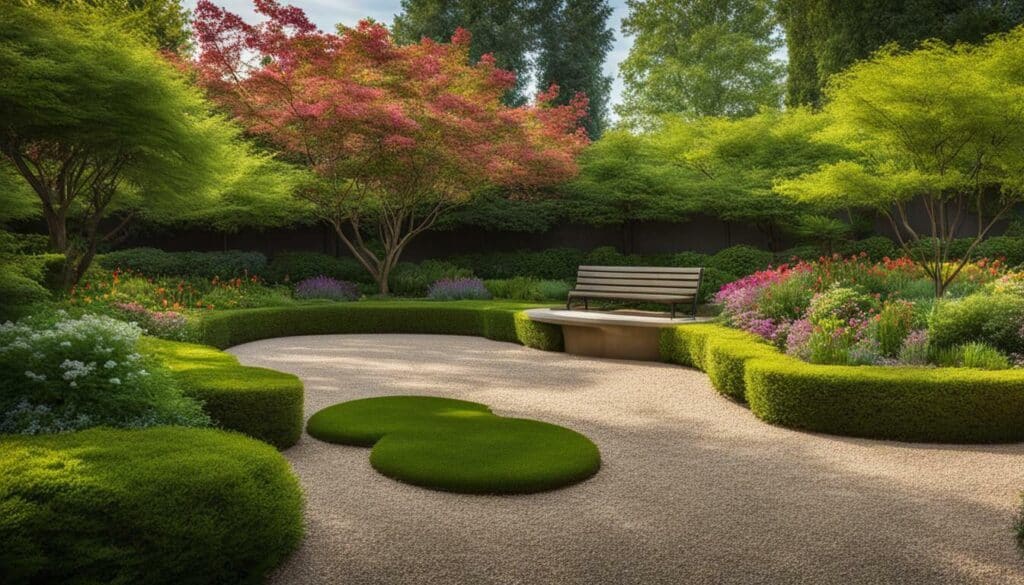
One of the key strategies for low maintenance gardening is to choose plants that are naturally resilient and require minimal care. Look for varieties that are drought-tolerant, disease-resistant, or can withstand fluctuations in temperature. These plants will be more likely to thrive with less attention from you, allowing you to enjoy your garden without constantly tending to its needs.
Table: Low Maintenance Plant Options
| Plant Type | Characteristics |
|---|---|
| Succulents | Drought-tolerant and require little water |
| Ornamental Grasses | Hardy and can add texture and movement to your garden |
| Lavender | Tolerates dry conditions and provides fragrant blooms |
| Japanese Maple | Stunning foliage and requires minimal pruning |
Another key aspect of low maintenance gardening is proper planning and design. By incorporating features such as mulch or ground covers, you can reduce weed growth and the need for regular maintenance. Additionally, consider using automated watering systems or installing a rain barrel to provide a consistent water source for your plants.
“A well-designed garden that takes into account low maintenance principles can save you time and effort while still providing a beautiful outdoor space.” – Gardening Expert
Lastly, don’t forget to periodically assess and adjust your garden’s layout and plant selections. As your garden grows, some plants may require more attention or become overcrowded. It’s important to be proactive in maintaining the balance of your garden to ensure it remains low maintenance.
With these tips and a little experimentation, you can create a beautiful and thriving garden that won’t demand much of your time. Embrace the low maintenance approach and enjoy your outdoor space without the stress of constant upkeep.
Using Mature Plants for Instant Impact
If you want to add instant impact to your garden, consider using mature plants that will provide a mature and established look. Mature plants have already reached their full growth potential, making them an excellent choice for creating a bold and confident garden design. These plants can instantly transform the appearance of your outdoor space and give it a more polished and well-established feel.
One way to incorporate mature plants into your garden is by choosing larger specimens that are already well-developed. These plants have a stronger presence and can immediately catch the eye. Whether you opt for trees, shrubs, or perennials, selecting mature specimens will give your garden a more sophisticated and visually appealing look.
Another option is to use container-grown plants that are already several years old. These plants have had time to mature and establish their root systems, making them more resilient and adaptable to their new environment. Placing these containers strategically in your garden can create focal points and add a sense of depth and dimension to your design.
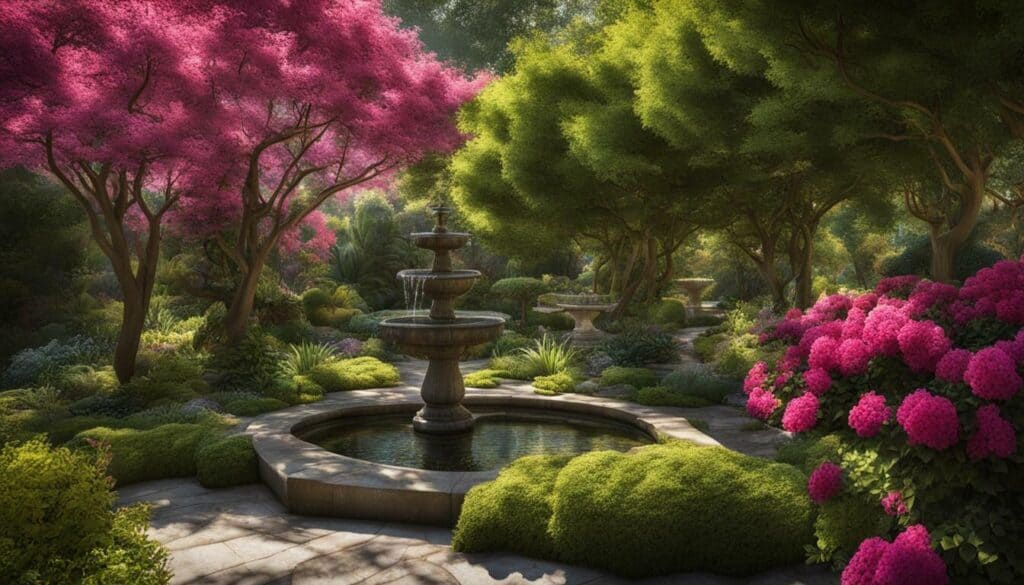
Bold Garden Designs
When working with mature plants, don’t be afraid to think big and create bold garden designs. Consider using plants with striking foliage, vibrant blooms, or unique shapes and textures to make a statement. Experiment with different color schemes, plant combinations, and landscaping techniques to create a visually stunning and captivating garden.
A well-designed garden should also incorporate other elements, such as pathways, seating areas, and decorative accents, to enhance the overall aesthetic. These additional features, when combined with mature plants, can create a harmonious and inviting outdoor space that you can enjoy and be proud of.
| Benefits of Using Mature Plants | Tips for Using Mature Plants |
|---|---|
|
|
“Using mature plants in garden design is like adding the finishing touches to a masterpiece. The instant impact they provide is unmatched, and they can truly transform a space into something remarkable.” – Gardening expert
Creating Natural and Breezy Designs with Container Gardens
Container gardens offer endless possibilities for designing beautiful and natural outdoor spaces. Discover how to mix different plant materials to create a breezy and effortless garden design.
When designing a container garden, it’s important to consider the combination of plants that will thrive together in the same pot. By mixing different plant materials, you can create a visually appealing arrangement that adds texture and depth to your outdoor space. For example, pairing tall grasses with trailing vines can create a vertical dimension, while adding colorful flowers or foliage can bring vibrancy to the composition.
Don’t be afraid to experiment with different colors, textures, and heights. Combining plants with varying growth habits can create a dynamic and visually interesting container garden. Consider using a tall, statement plant as the focal point and complementing it with a mix of low-growing and trailing plants.
Remember to choose plants that have similar light and water requirements to ensure they thrive together in the same container. Proper drainage is also crucial for the success of your container garden. Be sure to use well-draining soil and provide adequate drainage holes in your pots.
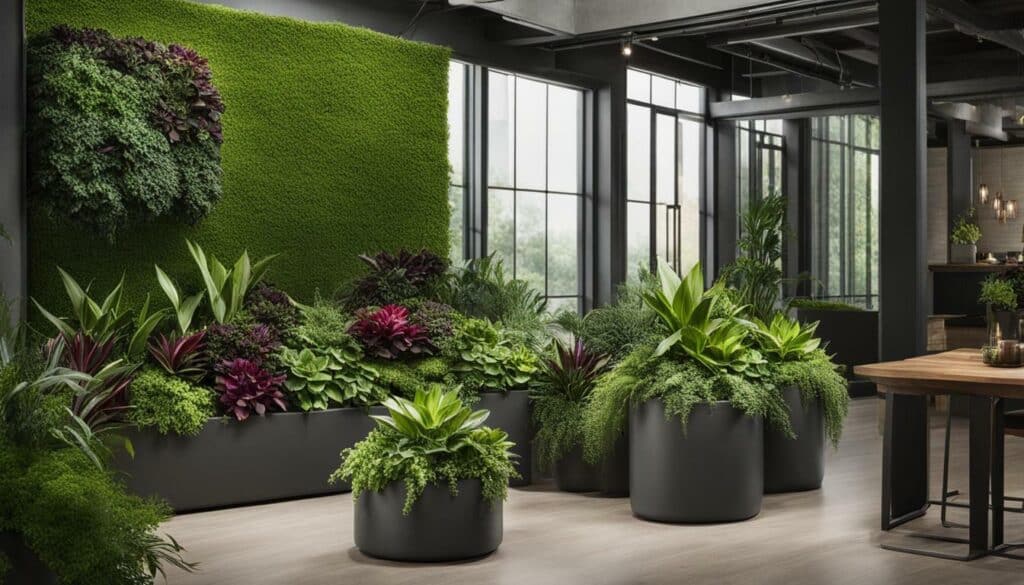
Creating a Breezy Container Garden: A Step-by-Step Guide
- Select a container that is appropriate for the size and growth habits of your chosen plants. Consider the style and material of the container to complement your overall garden design.
- Choose a variety of plants with different heights, textures, and colors. Aim for a mix of thrillers (tall plants), fillers (medium-sized plants), and spillers (trailing plants) to create a well-rounded composition.
- Fill the container with a high-quality potting mix, leaving enough space for the plants to establish their root systems.
- Position the tallest plant in the center or back of the container, and arrange the remaining plants around it, taking into account their respective growth habits.
- Water the container thoroughly, making sure the soil is evenly moist. Monitor the moisture levels and water accordingly to prevent overwatering or underwatering.
- Place your container garden in a location that provides the appropriate amount of light for the chosen plants. Consider factors such as sun exposure and shade patterns throughout the day.
- Maintain your container garden by regularly checking for pests, fertilizing as needed, and pruning to maintain the desired shape and size of the plants.
| Plant Combination | Light Requirement | Water Requirement |
|---|---|---|
| Tall grasses + Trailing vines + Colorful flowers | Full sun | Regular watering |
| Ornamental cabbage + Pansies + Ivy | Partial shade to full sun | Regular watering |
| Lavender + Sedum + Thyme | Full sun | Low water requirement |
“Container gardens allow for endless creativity and flexibility in designing your outdoor space. By mixing different plant materials, you can create a beautiful and breezy garden that reflects your personal style. Experiment with different combinations and let your creativity flourish!”
With these tips and a little creativity, you can create a stunning container garden that adds beauty and charm to your outdoor oasis. Mix different plant materials, choose the right container, and provide proper care to ensure your container garden flourishes throughout the seasons. Let nature be your guide as you design a breezy and effortless garden that will delight both you and your visitors.
Adding Romance with Enchanting Vines
Want to add a touch of enchantment to your garden? Explore the world of growing vines and create a romantic and captivating garden design. Vines are a versatile and beautiful addition to any outdoor space, offering vertical interest, lush foliage, and stunning blooms. Whether you have a small courtyard or a sprawling backyard, there is a vine that will fit perfectly into your garden design.
One of the advantages of growing vines is their ease of care. With proper training and support, they can quickly cover pergolas, trellises, or walls, adding a touch of whimsy and beauty to your garden. Some popular vine options include Clematis, Passionflower, and Honeysuckle, each offering its own unique charm.
| Vine | Type | Growth Pattern | Bloom Time |
|---|---|---|---|
| Clematis | Perennial | Climber | Spring to Fall |
| Passionflower | Perennial | Climber | Summer to Fall |
| Honeysuckle | Perennial | Climber | Spring to Fall |
Incorporating vines into your garden design not only adds visual appeal but also attracts beneficial pollinators such as bees and butterflies. The vibrant colors and enticing fragrances of these flowers will create a sensory experience that will make your garden truly magical.
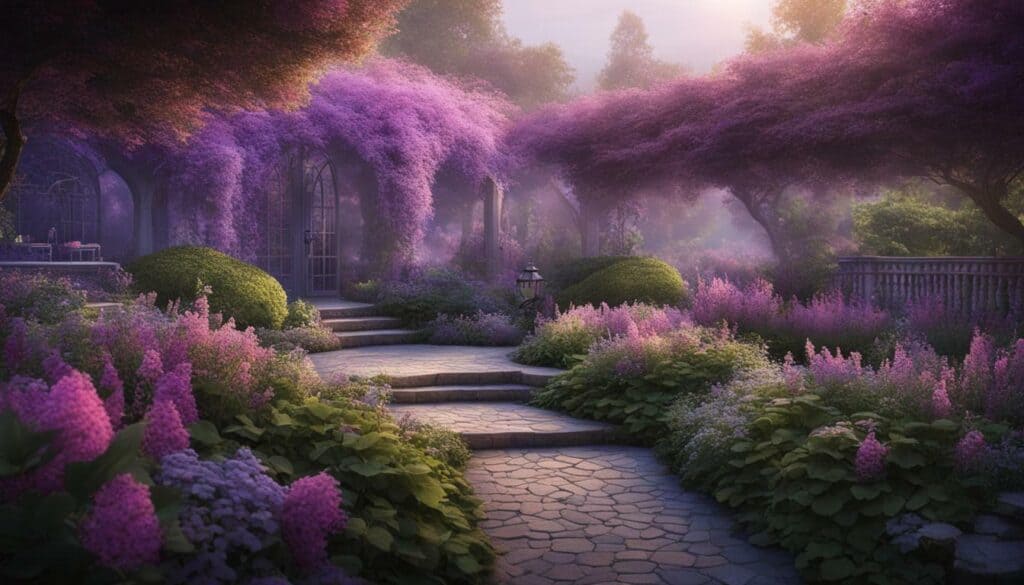
Quote:
“Vines have a way of transforming a space into a romantic oasis. The intertwining foliage and delicate blooms create a sense of wonder and enchantment.” – Garden Design Expert
When selecting vines for your garden, consider factors such as their growth habit, bloom time, and maintenance requirements. Some vines, like Wisteria, can be invasive and require regular pruning to keep them in check. Others, like Climbing Roses, may need additional support or training. By choosing the right vine for your specific needs, you can ensure a successful and awe-inspiring garden design.
So, why not unleash your creativity and let vines weave their magic in your garden? With their romantic allure and captivating beauty, vines will transform your outdoor space into a sanctuary of tranquility and romance.
Incorporating Statement Trees for Impact
Don’t overlook the impact of statement trees in garden design. Discover how to incorporate these majestic features into your landscape and create a garden that leaves a lasting impression. Statement trees are larger, prominent trees that serve as focal points in your garden, drawing attention and adding depth and interest to the overall design. These trees can be used to create a sense of scale, provide shade, or add a touch of drama to your outdoor space.
When incorporating statement trees, it’s important to consider their size, shape, and color. Choose trees that complement the overall aesthetic of your garden and create a harmonious balance with other plants and structures. For example, tall, slender trees like the Italian Cypress can create a sense of elegance and sophistication, while broad, spreading trees like the Magnolia bring a sense of grandeur and beauty.
To make a statement tree truly stand out, surround it with complementary plants and features. Consider adding flowering shrubs or vibrant perennials at the tree’s base to create a stunning visual display. You can also incorporate decorative elements such as benches, sculptures, or lighting to further enhance the impact of the tree.
Choosing the right statement tree
Selecting the right statement tree for your garden is crucial to creating an impactful design. Consider factors such as the tree’s growth habit, maintenance requirements, and suitability for your climate. Some popular statement trees include the Japanese Maple, with its delicate foliage and vibrant fall colors, and the Weeping Willow, renowned for its graceful, cascading branches.
Before planting a statement tree, ensure you have enough space for it to grow and thrive. Consider the tree’s mature height and spread to allow for proper spacing and prevent overcrowding. Additionally, ensure the tree’s soil and sunlight requirements align with the conditions in your garden.
By incorporating statement trees into your garden design, you can create a visually stunning and impactful outdoor space. These trees not only add beauty, but also provide shade, privacy, and habitat for wildlife. So, plant a statement tree today and watch your garden blossom into a captivating oasis.
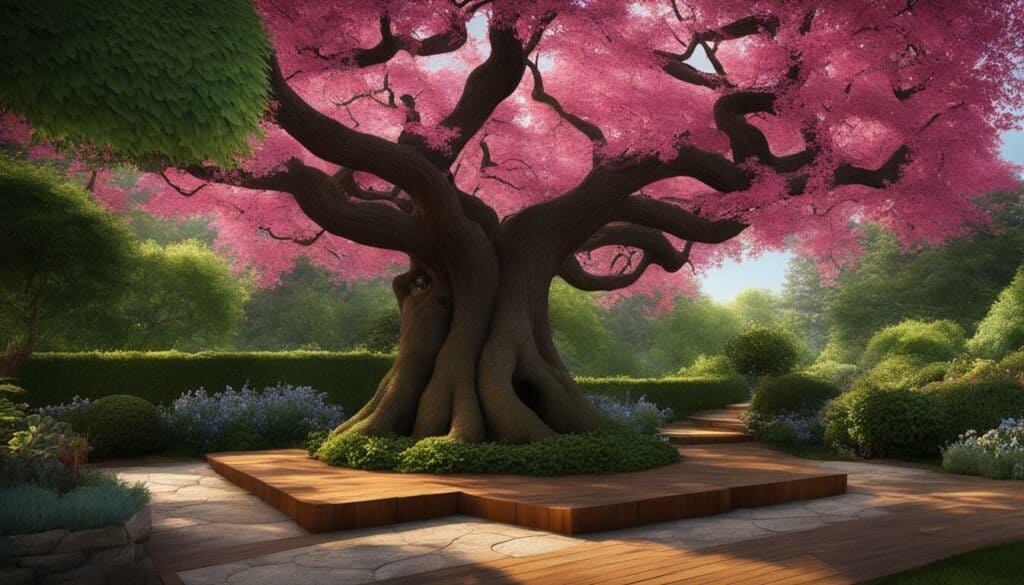
| Statement Tree | Features | Mature Height | Suitable Climate |
|---|---|---|---|
| Japanese Maple | Delicate foliage, vibrant fall colors | 10-25 feet | USDA zones 5-8 |
| Weeping Willow | Graceful, cascading branches | 30-50 feet | USDA zones 6-8 |
| Italian Cypress | Tall, slender shape | 40-60 feet | USDA zones 7-10 |
| Magnolia | Broad, spreading canopy, fragrant flowers | 20-40 feet | USDA zones 4-9 |
Adding Beauty and Movement with Perennials and Shrubs
Add beauty and movement to your garden with carefully selected perennials and well-manicured shrubs. In this section, we’ll show you how to create a visually stunning garden that will impress all who visit.
Perennials are a great addition to any garden as they come back year after year, adding color and texture to your outdoor space. Choose a variety of perennials that bloom at different times of the year to ensure a continuous display of vibrant flowers. Some popular options include lavender, daylilies, and coneflowers. Pair these with well-manicured shrubs such as boxwood or yew for a polished and sophisticated look.
When designing your garden, consider creating different levels by using varying heights of perennials and shrubs. This will add depth and interest to the overall design. Additionally, incorporating ornamental grasses can bring movement and texture to your garden, creating a dynamic and visually appealing landscape.
| Perennials | Shrubs |
|---|---|
| Lavender | Boxwood |
| Daylilies | Yew |
| Coneflowers |
Remember to choose plants that thrive in your specific climate and growing conditions. Consider factors such as sun exposure, soil type, and water requirements when selecting perennials and shrubs for your garden. By giving these plants the proper care and attention, you can create a beautiful and thriving garden that will be the envy of your neighbors.
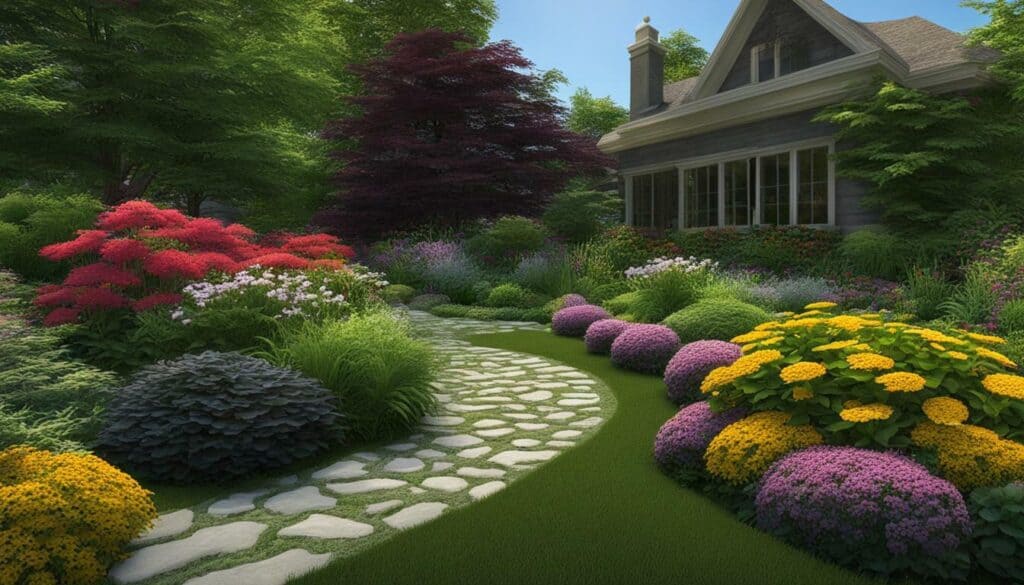
Conclusion
Designing a beautiful and thriving garden is within your reach! By following these basic garden design ideas and incorporating your own creativity, you can create an outdoor oasis that will bring joy for years to come.
If you have poor soil or limited space, don’t worry. Consider using raised beds or containers to overcome these challenges. Raised beds provide better drainage and can be filled with high-quality soil, while containers allow for flexibility and can be placed in various locations.
Adding a greenhouse to your garden can also be a game-changer. It not only extends your growing season but also provides protection for your plants against harsh weather conditions. With a greenhouse, you can experiment with a wider variety of plant species and enjoy fresh produce for a longer time.
When it comes to garden design, thinking big can have a dramatic impact. Incorporating mature plants into your garden creates an instant visual appeal and a sense of maturity. These plants have already established their roots and can add depth and character to your outdoor space.
For a natural and breezy feel, don’t be afraid to mix different plant materials in containers. By combining different colors, textures, and heights, you can create a harmonious and effortless look. This approach is perfect for those who want to add a touch of creativity and uniqueness to their garden design.
Another way to add charm and beauty to your garden is by growing vines. Vines are easy to care for and can quickly cover trellises, fences, or pergolas. Their vibrant foliage and delicate flowers can add a touch of romance and create a tranquil atmosphere in your outdoor space.
Consider using low-maintenance plants in your garden design. These plants require less frequent watering, pruning, and overall maintenance, making them ideal for those with busy lifestyles. By incorporating low-maintenance plants, you can spend more time enjoying your garden rather than tending to it.
Incorporating statement trees can also make a big impact on your garden design. These trees serve as focal points and draw attention with their unique shapes, colorful leaves, or beautiful flowers. Choose trees that suit your climate and personal preferences, and strategically place them to create a visually stunning and impactful garden.
Perennials and well-manicured shrubs are great choices for adding beauty and movement to your garden. Perennials come back year after year, providing a consistent display of colors and textures. Well-manicured shrubs can be pruned into various shapes and sizes, adding structure and visual interest to your garden design.
Remember, choosing the right soil, keeping critters away, and watering your plants correctly are essential for a thriving garden. Take the time to research the specific needs of your plants and provide them with the necessary care and attention. With these tips and a little experimentation, you can create a beautiful and vibrant garden that will be the envy of your neighborhood.
So, roll up your sleeves, put on your gardening gloves, and let your creativity flow. Your outdoor oasis awaits!
Can I Use the Basic Garden Bench Plans to Complement my Basic Garden Design?
Yes, you can use basic garden bench plans to complement your basic garden design. These plans provide a framework that can be tailored to suit your garden’s aesthetic. By incorporating a basic garden bench, you can add functionality and visual appeal, enhancing the overall charm of your outdoor space.
FAQ
Q: Can I create a beautiful garden if I have poor soil or limited space?
A: Yes, you can! Consider using raised beds or containers to work around poor soil or limited space. These options allow you to control the quality of soil and maximize space efficiently.
Q: How can a greenhouse benefit my garden?
A: A greenhouse can extend your growing season by providing a controlled environment for your plants. It also offers protection from harsh weather conditions and pests, ensuring healthier and more productive plants.
Q: Is it okay to mix different plant materials in containers?
A: Absolutely! Mixing different plant materials in containers can create a natural and breezy feel. It adds visual interest and allows you to experiment with various colors, textures, and heights.
Q: Are vines easy to care for?
A: Yes, vines are generally low-maintenance plants. They can add a touch of romance and elegance to your garden with minimal effort. Make sure to provide proper support for the vines to climb and enjoy their beauty.
Q: Should I consider using low-maintenance plants in my garden design?
A: Yes, incorporating low-maintenance plants in your garden design can save you time and effort. These plants require less watering, pruning, and fertilizing, allowing you to enjoy your garden without constant upkeep.
Q: How can I create impact in my garden design?
A: Consider incorporating statement trees into your garden. These trees can create a focal point, add height, and provide shade. Choose trees with unique features or stunning blooms to make a bold statement in your outdoor space.
Q: What can perennials and well-manicured shrubs bring to my garden design?
A: Perennials and well-manicured shrubs add beauty and movement to your garden. They come back year after year and can provide colorful blooms and interesting foliage. Proper pruning and maintenance will keep them looking their best.
Q: How important is choosing the right soil for my garden?
A: Choosing the right soil is crucial for the health and success of your garden. Different plants have different soil requirements, so it’s essential to understand their needs. Consider conducting a soil test to determine any necessary amendments.
Q: How can I keep critters away from my garden?
A: There are several ways to keep critters away from your garden. Install fences or use natural repellents, such as garlic spray or predator urine. You can also opt for companion planting to deter pests or consider using physical barriers.
Q: What is the proper way to water my plants?
A: Watering your plants correctly is essential for their health. It’s best to water deeply and infrequently, ensuring the water reaches the plant’s roots. Avoid overwatering, as it can lead to root rot. Consider using a soaker hose or drip irrigation system for efficient watering.

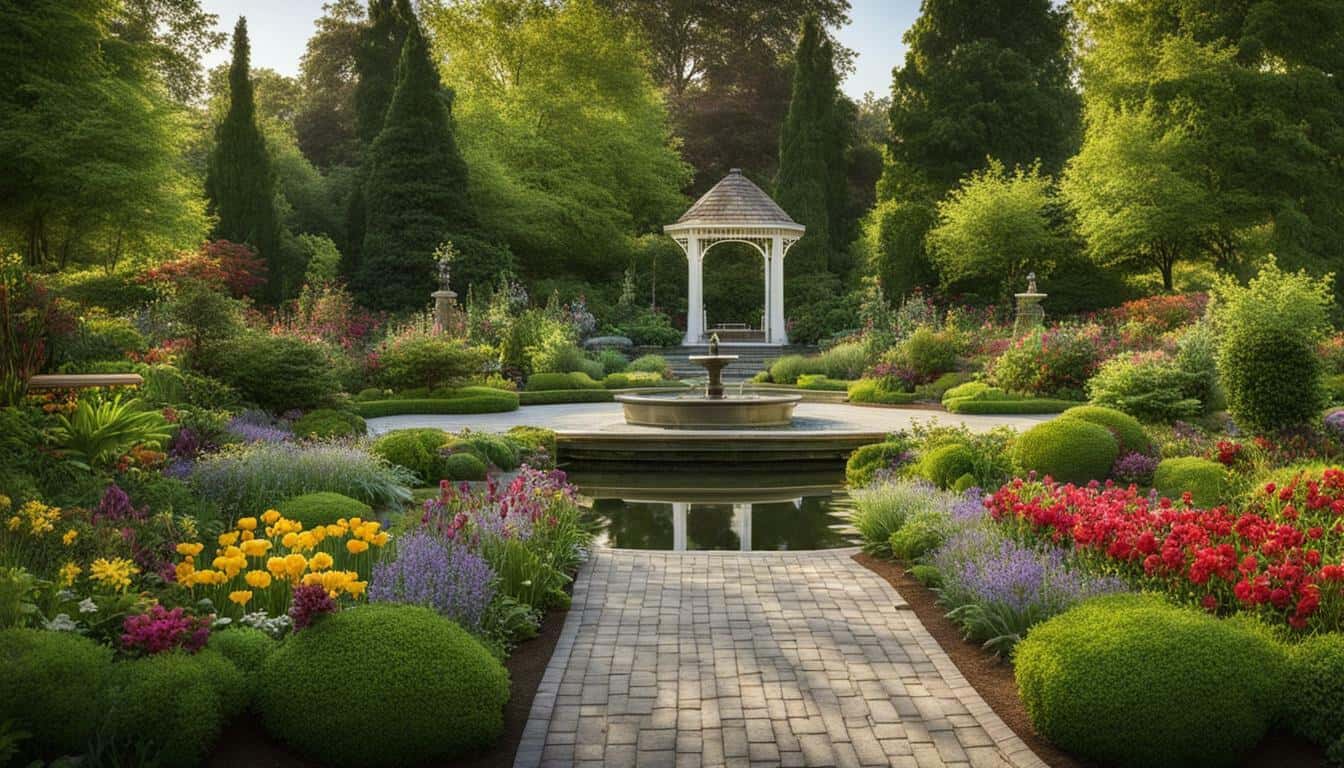



Leave a Reply